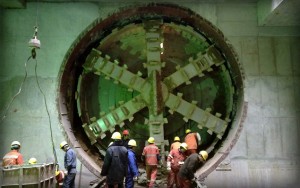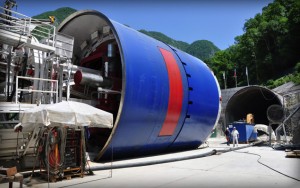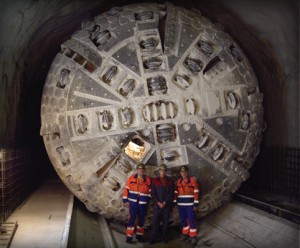Archives: Projects
墨西哥城的TEO项目
三台罗宾斯盾构机为墨西哥重要的污水隧道作业
项目概况
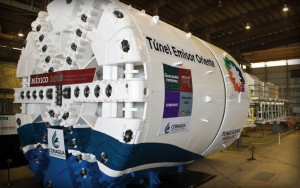
紧急为了防止洪水在城市首都墨西哥城, 国家水资源委员会(CONAGUA)已下令修建62公里(39英里)长的污水隧道 伊米苏. 奥连特(Emisor Oriente,简称TEO),这将有助于增加墨西哥城的排污水能力和缓解城市的一些相关问题。在雨季,暴雨和持续的洪水已经增加了这项工作的紧迫性,并迅速使之成为该国最重要的基础设施项目
该项目被分成6个标段,分别授予墨西哥承包商Ingenieros(ICA),S.A. de C.V.第1、2和5标段,授予Carso Infraestructura y Construcción, S.A. de C.V.第3和4标段;授予Lombardo Construcciones and Constructora Estrella 第6标段。三台直径8.93米(29.3英尺)的罗宾斯土压平衡盾构机(EPBs)负责开挖第1、3、4和5号标段隧道。
地质概
墨西哥城位于墨西哥的山谷中。这个地区有一个古老的,干涸的湖床,周围环绕着火山山脉。土壤主要由水粘土组成,其深度达80米(263英尺),地下水位仅为2至3米(6.6至9.8英尺)。地面也有高达600毫米(24英寸)直径的巨砾。由于复杂的地面条件,工程师们多年来一直认为,地质很难挖掘。尽管具有挑战性的地形,墨西哥城的主要污水管道——伊米苏中部,于1964年在地下开采了大约100米(328英尺),为未来的地下建设项目铺平了道路。
机器特征
罗宾斯的盾构机是为专门为项目的特别困难地质而设计的。虽然在2009年和2010年的矿井挖掘工作中发现了困难的地质,但在这一过程中,发现了比原先预计的复杂得多的地形,导致了对每台机器的各种修改。盾构机采用混合、背装式刀盘和硬质合金刀头,以处理各种不同的地面条件,并采用带式螺旋输送机来拆卸大卵石。重新设计的压力舱壁被添加到机器上,以适应该地区较高的水压,并增加了磨损检测,以确保最佳性能。在每台机器后面都使用了罗宾斯的连续输送机系统,以便快速地从排渣,减少停机时间。一旦机器从始发上开挖150米(492英尺)的距离,就会安装一个连续的输送机系统统和垂直带
隧道掘进
 2011年7月13日,一台罗宾斯盾构机在1号标段始发,这是该公司最初计划在5号标段的隧道驱动安排。1号标段的洪水使原本预计花6个月完成掘进的海瑞克机器推迟了,这促使承包商使用罗宾斯的盾构机。这台机器在第1号标段的5号竖井开始掘进机,利用与地面连接的脐带和泥浆泵进行出渣。
2011年7月13日,一台罗宾斯盾构机在1号标段始发,这是该公司最初计划在5号标段的隧道驱动安排。1号标段的洪水使原本预计花6个月完成掘进的海瑞克机器推迟了,这促使承包商使用罗宾斯的盾构机。这台机器在第1号标段的5号竖井开始掘进机,利用与地面连接的脐带和泥浆泵进行出渣。
由于墨西哥城主要的开放下水道线路——格兰运河的问题,第1号标段的挖掘问题很快被发现了。这条运河是在1910年建成的,定期向其直流大量涌入,导致道路关闭,给城市居民带来严重的健康问题。这条运河有一个垂直直流,可以导致大量的水可能会使当前的泵站超负荷,并将未经处理的水送回城市。这条运河的斜坡损失是由于该地区正在下沉的黏土造成的。为了解决这一问题,在一号标段的5号竖井中建造了一个处理厂和泵站,因此从格兰运河的一部分分流到米特或奥里特河可以被抽回到格兰运河,那里的斜坡没有被破坏。尽管第一台盾构机面临许多挑战,但它在15个月后取得一个成功的贯通。一旦罗宾斯盾构机开挖了4.6公里(2.9英里),它就被拆卸。然后在5号标段重新组装,并且在2014年初开始开始掘进它原来长8.6公里(5.3英里)的隧道标段。
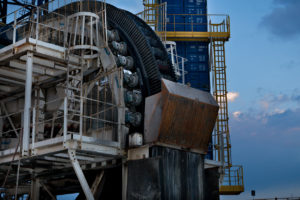
剩下的两台罗宾斯2012年开始挖掘,分别为3号标段的9.2公里(5.7米)和4号标段的10.2公里(6.3米)。掘进一开始,这些机器很快就会遇到磨蚀的玄武岩岩石和灰尘、石块和块状的地面,让设备的刀具和刀盘受到磨损。恶劣的地质条件更增加了一些刀具和螺旋输送机的磨损和损坏
为了应对挑战带来突然影响和保持对形势的控制,3号和4号标段的操作马上成为了高优先级处理行动。通过一个新的转接头的设计,使改进了中心滚刀的换刀时间。为了减少刀盘的磨损,更耐用的面和规格的刮刀被加到刀盘上
在3号标段的机器在完成了它的2.7公里(1.6英里)隧道后,还经历了额外的变化。这台机器被换了一个新的刀盘,配备了铬合金耐磨板和更小的开口以减少堵塞。这台机器还配备了采用特殊的耐磨板的新设计螺旋输送机,并增加了额外的门和注入端口。
在第4号标段,其他的罗宾斯机器在柔软的岩石中表现得更好,尽管要处理很多水压力,这台机器甚至还有28环的掘进记录。
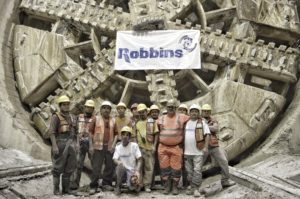 第5号标段的罗宾斯机器,来自1号标段,在第5号标段作业开始之前需要进行重大的修改,以帮助处理预期的高达7巴的水压。在墨西哥的一个民用工程项目中最深的竖井(150米的深井)中始发,安装了新的高压舱,以及一个用于压缩机和空气罐的新台车。为了加速在刀盘更换中央滚刀时间,转接头也被修改了。
第5号标段的罗宾斯机器,来自1号标段,在第5号标段作业开始之前需要进行重大的修改,以帮助处理预期的高达7巴的水压。在墨西哥的一个民用工程项目中最深的竖井(150米的深井)中始发,安装了新的高压舱,以及一个用于压缩机和空气罐的新台车。为了加速在刀盘更换中央滚刀时间,转接头也被修改了。
直至2017年,3号标段已完成了60%,4号标段完成将近70%,5号标段也完成了将近60%。
项目掘进情况会持续更新
西安地铁一号线
罗宾斯盾构机在中国古城下作业
项目概况
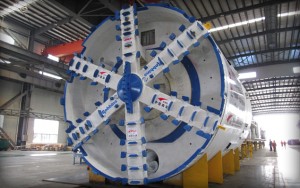 2010年6月和7月,西安地铁1号线的开工仪式开始于从长乐坡到万寿路的两台罗宾斯机器,这是该项目的第一个隧道掘进机开挖隧道项目
2010年6月和7月,西安地铁1号线的开工仪式开始于从长乐坡到万寿路的两台罗宾斯机器,这是该项目的第一个隧道掘进机开挖隧道项目
西安全长26.4公里的地铁1号线将从北向南贯穿市中心。10台隧道掘进机,包括两台直径6.2 米的罗宾斯盾构机,挖掘了新的铁路路线。这条路线直接在一些3100年历史上最敏感的遗址,包括兵马俑
中铁局第十一局承担1号线的第12标段。平行3.6公里的隧道经过4个明挖站,包括长乐坡、万寿路、康福路、金华路,浅覆盖范围从8米到22米不等。这两盾构机是第一个开始在一号线开挖的机器,随后又有8台其他机器在挖掘它们各自的标段
2009年6月,中铁十一局集团有限公司与中国铁路总公司签订了总供货合同。第二台机器装配于2010年4月在成都附近的一家制造工厂完成,然后运往工地。
地质状况
Both Robbins machines were optimized for geology including sand, abrasive pebbles and clay with significant ground water. Spoke-type cutterheads and 800 mm (32 in) diameter shaft-type screw conveyors aided in efficient advance while maintaining a water-tight seal and balanced pressure.
两台罗宾斯机器都对地质条件进行了优化,包括砂砾、磨砂卵石和具有重要地下水的粘土。在保持水密密封和平衡压力的过程中,辐条式的刀盘和800mm(32英寸)直径轴式螺旋输送机帮助提高了效率。
隧道掘进
12标段位于人口密集的城市地区,隧道在大学、医院和市场的下方。机组人员通过调整推力、前进速度和螺旋输送机速度,不断监测开挖速度和整体清除量,同时保持刀盘速度较低,每分钟旋转1次。在隧道对准的早期部分,也出现了可折叠的、含水泥土的部分。机组人员采取了类似的措施,包括在混合室进行严格的土压控制,再加上膨润土和土壤条件的水
隧道是更加复杂的全市条例限制定居点±15毫米;明显低于大多数中国隧道工程典型的25毫米限值。严格的解决准则,由于古老的结构而实施的谨慎,需要两台罗宾斯盾构机的专门设计
最后一次中间突破发生在2011年7月28日,金华路站。左线盾构机的进尺为每月579米(386环),每天36米(24环)。在明挖洞范围内进行了计划的维护,如更换刀具和尾封刷,以及液压系统和电气系统的检查。由逆变器和两个部分组成的半段环被安装,以允许机器在140米长的站点上“行走”。
右线盾构机的进尺同样高达每月453米(302环),每天39米(26环)。沉降在15毫米以下,平均沉降5毫米。
2011年夏季,有一台机器最近完成了万寿路与金华路之间的第二段隧道,另一架在金华路和康福路的最后一段土层黄土条件下。
这些机器在2011年最后一个季度完成了隧道的挖掘工作。一旦在2013年上线,全长26.4公里(16.4英里)的地铁1号线将会把整个城市的交通时间从一个小时缩短到39分钟。
俄罗斯索契3号交通枢纽
罗宾斯双护盾为奥运会打造新通道
项目概况
2012年,直径6.18米和10.0米的翻新罗宾斯双护盾硬岩隧道掘进机为俄罗斯索契分别贯通了一条5.8公里的服务隧道和4.6公里的铁路隧道。 这个隧道工程师俄罗斯为迎接2014年冬季奥运会开展的公路和轨道交通改造重大工程项目的一部分。
这一交通改造工程由俄罗斯铁道部下属的机构DCRC-索契启动。工程共分为6个综合交通枢纽交汇处,链接在黑海沿岸的阿德勒小镇和阿皮卡的度假山庄道路和铁路。这些新建的隧道线路将会链接途经46座桥和12条隧道穿过国家森林的M-27号公路这条姆济姆塔河沿线。
整个项目由有长达共48.2公里的新建公路和铁路隧道组成。规定必须在2013年的6月完成的这个项目为了能确保工程能在按时竣工,开挖隧道采用了多种方法,包括巷道掘进机、爆破设备和5台隧道掘进机。
量身定做的翻新
项目的承建商OJSC Stroy-Trest和CSC Bamtunnelstroy公司采用了2台翻新的罗宾斯掘进机来挖掘平行的服务和铁路隧道。采用翻新设备开挖隧道可以大大节省采购时间,能让工程可以在规定的、非常短工期内预期完工。负责开挖3号综合交通枢纽交汇处隧道的三台隧道掘进机中,有两台属于罗宾斯制造的掘进机。其中直径10米的掘进机曾在2003年至2006年间用于开挖西班牙的阿贝达拉吉斯铁路隧道。直径6米的掘进机则是在1993年为瑞士水利发电项目而制造的,至今已服务过多个不同的隧道项目,开挖隧道共长达45公里。
直径10米的掘进机开始是由第三方供应商进行翻新提供。当始发后遇到了许多问题,发现一部分的主要部件需要翻新或更换,Bamtunnelstroy决定雇佣掘进机的制造商罗宾斯公司为3号综合交通枢纽交汇处隧道项目提供现场技术支持和项目咨询。
罗宾斯从现场服务和工程部派出了15个专家组成的技术团队修理和改装两台双护盾的硬岩隧道掘进机。为了配合困难的掘进条件,这两台掘进机都配备了扁平的碴石铲斗和径向铲斗以提高工作面的稳定性。设计还包括了可换式铲斗齿和喷射注入口,使得泡沫添加剂可以穿过刀盘注入工作面进行土壤改良。这些改良的设计让设备顺利经过了多个断裂地带。
复杂地质
这个项目的地质状况极为复杂,既有块状的掩体,又有粘土裂缝性灰岩。在3号综合交通枢纽交汇处这个标段的地质尤其困难,共有27个断裂地带。2010年5月,直径6.18米的掘进机曾因碎岩和流质土体构成的断层而中断作业,现场服务人员和操作人员在掘进机四周挖出一条旁通隧道,减轻了刀盘的压力,成功地恢复了设备的掘进。重新启动后,采用了超前钻孔以及注入硅酸盐水泥和泡沫的预注浆技术确保设备正常掘进。
隧道掘进
尽管在2010年的5月18日至8月8日遇到了坍塌,直径6.18的掘进机仍然于2011年9月2日成功贯通了服务隧道;取得了日进尺14米,平均周进尺100到120米的成绩。2012年4月12日,直径10.0米的掘进机也顺利贯通了铁路隧道,完成了罗宾斯两台掘进机在最复杂的3号综合交通枢纽交汇处隧道项目标段的工作。
郑州地铁一号线
罗宾斯又一次在中国创下进速度的里程碑
项目概况
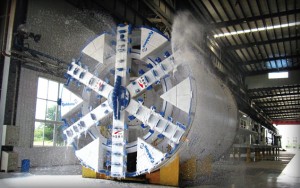 这个郑州地铁项目由两条地下隧道组成,属于中铁十一局为郑州承建首条地铁线路项目里的一部分。郑州是一个拥有700万人口的大城市,新建成的地铁线路将缓解城市交通堵塞的问题。连接北京至广州(南北双向),以及连接徐州至兰州(东西双向)的运输线路最终会在郑州相交。计划将修建的四条地铁线路将会帮助郑州成为中国未来轨道运输系统的中心,。长达26公里的整条郑州地铁一号线将于2013年竣工,途径22个站点。预计总投资达1000亿人民币的郑州地铁线路计划在2015至2030年建成,总长将达188公里。
这个郑州地铁项目由两条地下隧道组成,属于中铁十一局为郑州承建首条地铁线路项目里的一部分。郑州是一个拥有700万人口的大城市,新建成的地铁线路将缓解城市交通堵塞的问题。连接北京至广州(南北双向),以及连接徐州至兰州(东西双向)的运输线路最终会在郑州相交。计划将修建的四条地铁线路将会帮助郑州成为中国未来轨道运输系统的中心,。长达26公里的整条郑州地铁一号线将于2013年竣工,途径22个站点。预计总投资达1000亿人民币的郑州地铁线路计划在2015至2030年建成,总长将达188公里。
地质状况
郑州的地质属于富含粘土和粉土状的典型复合地质。掘进施工遇到了很多挑战,特别是途径的西流湖的那段,隧道上表面离湖底稳定层只有2.2米,盾构机需要相当稳定地掘进,只要稍微的扰动,就会出现涌水现象。还有,隧道途径西流湖附近的建筑物和西三环立交桥的覆盖层仅有7米。此外,近半条隧道离地面的覆盖层仅有8米。为了让两台盾构机都能同时在市中心下面进行掘进和减少施工造成的沉降现象,泡沫和膨润土同时随着盾构机掘进注入到土层里。同时,施工人员也采用通过对掘进机的速度和出渣量进行严格监控的技术防止沉降。
机器特点
两台盾构机的推力达36,000kN和最大扭矩达5,128kNm, 最大冲程达1,950mm。两台盾构机配备了辐条加面板式刀盘。 刀盘上配备了碳化钨、贝壳刀、鱼尾刀和刮刀。刀盘由功率750kW的变频电机驱动,转速达0.3~2.0rpm每分钟。另外,盾构机安装了直径800mm的轴式螺旋输送机用以输送渣土。两台机器都安装了主动交接系统,允许盾构机字很小的半径曲率下掘进,并且保持管片顺利安装。以5+1布置的管片为钢筋混凝土结构,厚300mm, 长1.5米。 为了巩固隧道衬砌,减少沉降,回填注浆采用了单液式
隧道掘进
两条长3.6公里、相距3.6米的隧道连接凯旋路至桐柏路,途径四个中段站区。罗宾斯盾构机分别于2010年的11月和12月始发掘进。大部分都是在覆盖层8米左右的沙质 软土中、建筑地基以及高速公路立交桥之下完成的。泡沫和膨润土用以注入工作面改良土壤和降低沉降。在湖底下掘进时,操作人员小心地把土压保持在1.1至1.3bar之间,刀盘的转速为每分钟一转,因而减缓了该地段的掘进速度。在整个掘进过程中,沉降率一直保持在限制范围内。
2011年初,两台盾构机贯通了中段明挖站点。2011年10月和11月实现了贯通,比工程计划提前了至少两周时间。其中,第一台盾构机在施工中,创下3周进尺720米的郑州地铁隧道掘进纪录。尽管存在着以上不利因素以及在西流湖地下需要采取的特殊措施,日进尺速度最高依然达到了23环(34.5米),以两个10小时轮班制为一天。这些掘进速度的记录超越了同一项目下其余9台盾构机,创下了郑州地铁的项目记录。
Tahoe Forest Hospital District Central Energy Plant Prep Project
Project Overview
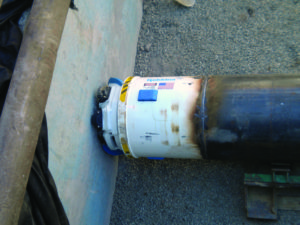 The Tahoe Forest Hospital is an expanding healthcare center located in Truckee, California. In autumn 2010, they were in the process of designing a new cancer wing when it was determined that additional utility and mechanical lines were required before the new building could be built. To house the bundled utilities, three crossings needed to be bored directly below the active main hospital.
The Tahoe Forest Hospital is an expanding healthcare center located in Truckee, California. In autumn 2010, they were in the process of designing a new cancer wing when it was determined that additional utility and mechanical lines were required before the new building could be built. To house the bundled utilities, three crossings needed to be bored directly below the active main hospital.
General contractor AM-X Construction & Excavation, Inc. subcontracted the three parallel 21 m (70 ft) sections to Silver State Boring Inc. Due to variable ground conditions and hospital noise constraints, the contractor opted for a Robbins SBU-A with a mixed ground head. This was the first time Silver State had used this type of cutterhead, but they were confident that it was the right machine for the job.
Geology
The hospital is set on ground containing large granite boulders, and Silver State was worried that one of these rocks would be hit during boring. This concern was actualized 7.6 m (25 ft) into the first bore when the SBU-A caught the edge of a boulder about 3.7 m (12 ft) in diameter. During the second bore, the machine drilled straight through the same boulder. Additional boulders of 175 MPa (25,000 psi) UCS were encountered during the third bore, and the SBU-A successfully powered through them as well.
What is a Mixed Ground SBU-A?
The Robbins SBU-A is a circular cutting head mounted with a combination of tungsten carbide bits, single disc cutters, and multi-row disc cutters. The SBU-A is available in diameters from 600 mm to 1.8 m (24 to 72 in), and can excavate a wide variety of hard rock and mixed ground conditions including dry soils, clay, cobbles and boulders from 25 to 175 MPa (4,000 to 25,000 psi) UCS.
During boring, the SBU-A is welded to an Auger Boring Machine (ABM), which provides both torque and thrust to the cutting head. Drag bits scrape soil from the machine face, while disc cutters excavate sections of rock. Muck scrapers scoop the excavated rock into large openings in the cutterhead, allowing for a smooth flow of muck from the face to the auger string.
Excavation
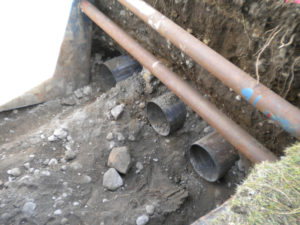 The SBU-A bored 2 m (8 ft) below the hospital’s foundation for the three jack-and-bore crossings. Straight bores were needed due to tight exit space, and each one began with a 609 mm (24 in) thick concrete starting block to keep the machine properly aligned. In addition, the older hospital has many buried utilities that needed to be cut and bypassed during site excavation. To make sure that everything would run smoothly, Robbins field service technicians visited the site prior to launch to assist with setup and crew training.
The SBU-A bored 2 m (8 ft) below the hospital’s foundation for the three jack-and-bore crossings. Straight bores were needed due to tight exit space, and each one began with a 609 mm (24 in) thick concrete starting block to keep the machine properly aligned. In addition, the older hospital has many buried utilities that needed to be cut and bypassed during site excavation. To make sure that everything would run smoothly, Robbins field service technicians visited the site prior to launch to assist with setup and crew training.
The first of the three bores began in October 2010, and by November 2010 all three bores were successfully completed. Advance rates for the duration of the project were approximately 3 m (10 ft) per day.
Due to the low torque and impact of the SBU-A, little stress was put on the ABM, no cutter changes were needed between bores, and the hospital was unaffected by noise or vibration during boring. Silver State was very pleased with the results, and used the technology again in 2011 for 609 mm (24 in) diameter bore in South Lake Tahoe, Nevada.
City of Clinton Contract B Force Main Project
Project Overview
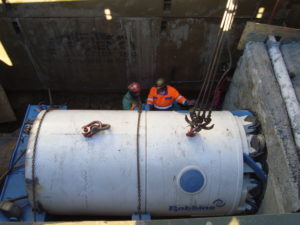 The Iowan towns of Clinton, Camanche and Low Moor have been identified as communities in desperate need of updated wastewater treatment systems. The towns all have over 10,000 residents, but their water and sewer treatment plants are inadequate and often over capacity. In 2009, a statewide recovery program called I-JOBS was created in Iowa, and USD $20 million in project funding was allocated to improving water quality. These funds were set aside for water treatment projects in the three towns.
The Iowan towns of Clinton, Camanche and Low Moor have been identified as communities in desperate need of updated wastewater treatment systems. The towns all have over 10,000 residents, but their water and sewer treatment plants are inadequate and often over capacity. In 2009, a statewide recovery program called I-JOBS was created in Iowa, and USD $20 million in project funding was allocated to improving water quality. These funds were set aside for water treatment projects in the three towns.
The City of Clinton awarded their portion of the funding, USD $9.5 million, to general contractor Merryman Excavation. Illinois-based L.J. Keefe Co. was chosen as the sub-contractor for the project. The contract, known as City of Clinton Contract B Force Main, called for six crossings below roadways and rivers, three of which required TBM tunneling. The remaining three crossings required SBUs. Two Robbins SBU-As were chosen for the 26.2 m (250 ft) and 82.3 m (270 ft) runs, and a third Robbins motorized SBU (SBU-M) was selected for the 120.4 m (395 ft) crossing.
Geology
The 26.2 m (250 ft) and 82.3 m (270 ft) crossings undercut the Mississippi river, and were identified as hard rock bores of over 70 MPa (10,000 psi) UCS in which SBU-As would be the best choice. The longest crossing was below traffic-heavy Highway 67, and testing of the area revealed a mixed face of sand, clay and 70 MPa (10,000 psi) UCS hard rock. Due to the variable ground conditions, the contractor opted for a 1.8 m (72 in) SBU-M, the largest of its kind yet built.
About the SBU-A
The Small Boring Unit (SBU-A) is a hard rock and mixed ground circular cutterhead which utilizes an Auger Boring Machine (ABM) and steel casing. During excavation, the SBU-A is welded to the lead casing while the ABM provides torque and forward thrust to the cutterhead.
The SBU-A is available in diameters ranging from 600 mm to 1.8 m (24 to 72 in), and its single disc cutters are capable of excavating rock from 25 to over 175 MPa (4,000 to over 25,000 psi) UCS. The cutters penetrate the rock face, creating a “crush zone” through which fractures occur. Material between adjacent crush zones falls from the face into muck buckets in the cutterhead. A full face auger is used to transfer the muck for removal.
About the SBU-M
The SBU-A’s cousin, the SBU-M, is a motorized SBU used for longer bores and line-and-grade critical crossings. In similar fashion to the SBU-A, the SBU-M is welded or bolted to the lead casing of an ABM. The machine is continuously steered by way of an operator’s console in the rear shield. A laser targeting system is used to monitor the machine’s heading. These features allow for increased accuracy and continuous monitoring, which was needed on the 120.4 m (395 ft) bore due to the mixed ground geology, strict line-and-grade requirements, and crossing length.
Excavation
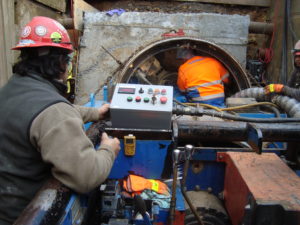 In November and December 2011, the 1.5 m (60 in) and 1.06 m (42 in) SBU-As, respectively, were launched 9.1 m to 10.6 m (30 to 35 ft) beneath a tributary of the Mississippi River. Each utilized an 18.3 m (60 in) ABM to excavate in the hard rock conditions. Both SBU-As broke through on time and within line-and-grade specifications. The first SBU reached completion on December 20, 2011, and its counterpart did the same on February 10, 2012. Each averaged advance rates of 6.1 m (20 ft) per day.
In November and December 2011, the 1.5 m (60 in) and 1.06 m (42 in) SBU-As, respectively, were launched 9.1 m to 10.6 m (30 to 35 ft) beneath a tributary of the Mississippi River. Each utilized an 18.3 m (60 in) ABM to excavate in the hard rock conditions. Both SBU-As broke through on time and within line-and-grade specifications. The first SBU reached completion on December 20, 2011, and its counterpart did the same on February 10, 2012. Each averaged advance rates of 6.1 m (20 ft) per day.
The 1.8 m (72 in) SBU-M was launched in January 2012 from a 7.6 m (25 ft) launch pit. Although the machine encountered an unexpectedly long drive of hard clay just 4.6 m (15 ft) into its bore, crews were able to keep moving by adding water through the cutterhead and the casing. This kept the muck coming through without contaminating the disc cutters.
Although challenging, advance rates of 6.2 m (20 ft) per day were maintained in the softer ground conditions. After about 70.1 m (230 ft) worth of clay, the machine hit solid rock for the remainder of the run. While in hard rock, rates increased to about 90.1 m (30 ft) per day.
On February 14, 2012, the SBU-M broke through into a receiving pit. It finished within line-and-grade requirements with very little deviation, even in the mixed face ground conditions during initial boring.
Nanjing Metro Line 3 Lot 11 & Line 10 Lot 5
Project Overview
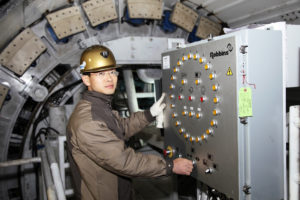 The world-famous Youth Olympic Games were held in Nanjing in summer 2014, bringing 40,000 visitors. This number, combined with the 750,000 people who rode the city’s rails on a daily basis, put the city in need of an extended metro system.
The world-famous Youth Olympic Games were held in Nanjing in summer 2014, bringing 40,000 visitors. This number, combined with the 750,000 people who rode the city’s rails on a daily basis, put the city in need of an extended metro system.
Two new metro lines were built to accommodate the anticipated increase in passengers. Robbins supplied four 6.5 m (21.4 ft) diameter EPBs with mixed ground cutterheads for Line 3 Lot 11 and Line 10 Lot 5, 40.2 km (25.0 mi) and 41.4 km (25.7 mi) long, respectively. The EPBs were part of about 40 TBMs used for the Nanjing Metro expansion.
Ground Conditions
Both lines were bored in soft ground consisting of silty sand, sandstone, small pebbles and man-made materials. The Qinhuai River, old historical structures, a railway and a viaduct were in close vicinity of the lines. Due to the ground conditions and nearby structural constraints, customized excavation methods were employed. The thrust force was kept very low at 6,000 to 9,000 kN (1.4 to 2.0 million lb), continuous monitoring was used to maintain proper alignment and earth pressure, and foam additive was applied to make the ground less sticky and reduce torque.
Excavation
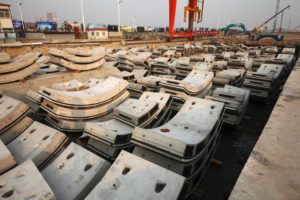 Two of the four 6.5 m (21.4 ft) diameter TBMs were launched for the 2,500 m (8,202 ft) Line 10 Lot 5 in December 2011 and February 2012. The second pair of machines for 2,030 m (6,660 ft) Line 3 Lot 11 began boring soon after in January and March 2012. All machines were assembled and launched from 10 m (33 ft) shafts.
Two of the four 6.5 m (21.4 ft) diameter TBMs were launched for the 2,500 m (8,202 ft) Line 10 Lot 5 in December 2011 and February 2012. The second pair of machines for 2,030 m (6,660 ft) Line 3 Lot 11 began boring soon after in January and March 2012. All machines were assembled and launched from 10 m (33 ft) shafts.
By August 2012, the Line 10 EPBs had excavated 720 m and 600 m (2,362 ft and 1,968 ft), with advance rates of 40 mm (1.6 in) per minute. Over at Line 3, the excavation had progressed as far as 600 m (1,968 ft) with rates topping 60 mm (2.4 in) per minute. Settlement for both lines stayed below the strict required limits of less than 20 mm (0.8 in). By 2013, all four machines had completed their respective tunnels with very favorable results.
The new Lines 3 and 10, now complete, combine with Nanjing’s two existing metro lines to handle the increase in rail riders. The lines will also serve as part of the municipal government’s extensive plan to build 17 new rail routes totaling 600 km (370 mi) across the Yangtze River Basin by 2030.
Shayler Run Segment C Sewer Replacement Project
Project Overview
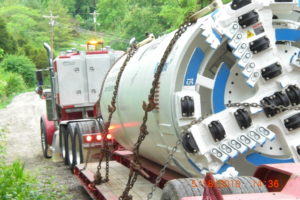 Seven new sewer tunnels were recently completed in Ohio’s Clermont County, replacing an outdated and exposed system that was dumping raw sewage into local Shayler Creek. Since 1978, when the previous pipeline was installed, the creek had eroded, exposing the pipe and putting certain sections of the line at high risk of failure. For all of these reasons, a new pipeline needed to be installed far below the environmentally-sensitive waterway.
Seven new sewer tunnels were recently completed in Ohio’s Clermont County, replacing an outdated and exposed system that was dumping raw sewage into local Shayler Creek. Since 1978, when the previous pipeline was installed, the creek had eroded, exposing the pipe and putting certain sections of the line at high risk of failure. For all of these reasons, a new pipeline needed to be installed far below the environmentally-sensitive waterway.
The Clermont County Water Resources Department hired Indianapolis contractor Midwest Mole for the $15M USD project, and chose to use only one machine for the seven tunnels. A 1.8 m (72 in) diameter Robbins Double Shield Rockhead was used to excavate all of the tunnels, totaling 2,900 m (9,513 ft). The contractor’s unique approach also included eliminating three shafts from the original bid, which shortened the project schedule and significantly lowered costs.
Ground Conditions
Because of the project location below the creek bed, ground conditions were highly varied, consisting of interbedded layers of limestone and shale that ranged from dry to sticky and wet. To accommodate the mixed ground, the machine was outfitted with a mixed ground cutterhead that could be swapped out for a hard rock cutterhead based on the ground conditions at each crossing.
The mixed ground cutterhead featured 6.5 in single disc cutters and carbide bits, while the hard rock cutterhead contained 11.5 in single cutters and abrasion-resistant muck scrapers. Both cutterheads had large openings which allowed for efficient cutter changes.
About the SBU-RHDS
The Robbins Double Shield Rockhead (SBU-RHDS) is a tunneling machine typically used on utility installations of over 150 m (500 ft). Its continuous steering capabilities and laser targeting system make it the ideal solution for line-and-grade critical installations such as the Shayler Run Segment C Sewer Replacement Project.
The SBU-RHDS is available in diameters from 1.4 to 2.0 m (54 to 78 in), and consists of a cutterhead optimized for mixed and hard rock ground conditions. The machine’s circular cutterhead contains disc cutters capable of excavating ground ranging from 25 to 175 MPa (4,000 to over 25,000 psi) UCS.
As the cutterhead rotates, the cutters penetrate the rock face creating “crush zones” through which fractures propagate. Material between adjacent crush zones is then chipped from the face. Muck scrapers scoop the muck into muck buckets, which transfer the muck onto a machine belt conveyor. Muck is transported offsite via conveyor belt or muck cars.
Excavation
 A total of seven tunnel crossings connected by eight shafts were constructed by Midwest Mole. The tunnels utilized the Rockhead, while the shafts were constructed using a combination of drill and blast techniques and manual excavation. A primary liner of ring beams and lagging was installed every 1.5 m (5 ft) at each crossing. Even with liner installation, high production rates of 12 to 18 m (40 to 60 ft) per 12-hour shift were maintained for the project duration.
A total of seven tunnel crossings connected by eight shafts were constructed by Midwest Mole. The tunnels utilized the Rockhead, while the shafts were constructed using a combination of drill and blast techniques and manual excavation. A primary liner of ring beams and lagging was installed every 1.5 m (5 ft) at each crossing. Even with liner installation, high production rates of 12 to 18 m (40 to 60 ft) per 12-hour shift were maintained for the project duration.
Due to the gravity sewer construction, each tunnel had strict line-and-grade requirements of within 300mm (1 ft) of line at 1 to 2% grade, which was continuously monitored from an in-shield operator’s console. Over the course of the project, the variance resulted in a vertical change of 53.9 m (177 ft) causing the machine to bore through a wide range of ground conditions.
Excavation of the initial 484.3 m (1,589 ft) crossing began in May 2010 in mixed ground, and the Rockhead broke through to its first shaft site that August. After a few minor modifications to the hydraulic and muck haulage systems, the machine began boring the second 575.4 m (1,888 ft) crossing.
Crossings 3 and 4, 321.9 m (1,056 ft) and 304.8 m (1,000 ft), respectively, were excavated in December 2010 and January 2011 in adverse winter weather conditions. In order to keep tunneling during freezing temperatures, the contractor heated the machine’s cooling water overnight. Cooling water was recycled and filtered, then stored in 7, 500 l (2,000 gal) tanks with heaters. Using this technique, production rates stayed high and both crossings were successfully excavated by January 2011.
The Rockhead began its fifth and longest crossing of 613.8 m (2,014 ft) in April 2011, and reached a world record in tunneling distance for a hard rock machine of its 1.8 m (72 in) diameter. For the last two crossings, 402.3 m (1,320 ft) and 196.9 m (646 ft), respectively, the mixed ground cutterhead was replaced with its hard rock counterpart.
Due to negotiations with local landowners and a change in shaft location, the final crossing began in January 2012. A month later, the drive was completed. In July 2012, the entire project reached completion right on schedule, with all manholes and ancillary sewers tied in and in service.
莫斯科地铁项目
项目概况
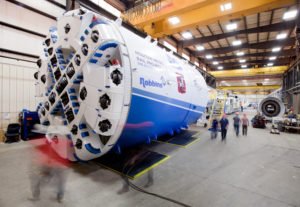
对于在莫斯科的每天上下班的人来说,花两个多小时的交通时间是家常便饭。随着人口近1200万的增长,莫斯科政府已经发布了一项大规模的城市地铁项目,到2018年将有50公里(31英里)的新地铁线路
在这个莫斯科地铁项目上,共采用了5台罗宾斯的土压平衡盾构机开挖隧道。总计算盾构机已经掘进超过8公里的隧道。
设备设计
所有的盾构机都是专门设计来处理该地区由细沙,沙砾,砂质壤土,坚硬的粘土和石灰石组成的复杂地质。每台盾构机都配备有混合地质的刀盘,可根据不同的情况,使用把滚刀更换硬质合金刀具。
除了有应对混合地质能力,每台盾构机都采用一台罗宾斯连续输送机系统,以最大效率出渣。由于该项目在莫斯科市中心,密集的城市环境,还需要使用地面监测设备来限制定沉降
这些机器是在莫斯科第一批使用变频驱动(VFDs)的掘进机。机器的高推力和扭矩能力允许更快的掘进,同时尽量减少可能导致地表沉降的扰动。在机器上的主动铰接使他们能够开挖出更紧密的弯度,同时不会出现管片变形的风险。
隧道掘进
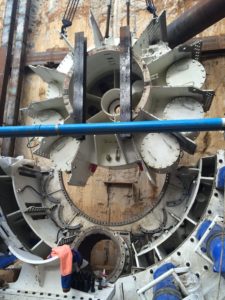
隧道掘进在数十个紧凑的施工现场进行,其特点是莫斯科具有挑战性的混合地质条件。三台新的罗宾斯高性能盾构机和一台命名为“茱莉亚”翻新的机器,在城市的不同地区作业。这些机器都是为项目量身定做的,可以对在城市复杂地质。
有三台罗宾斯的盾构机为施工商Engeocom作业; 两台直径6.6米的机器复杂开挖左右线隧道,每条隧道长度1.8公里,翻新机“茱莉亚”负责开挖一条2公里长的隧道。第四台直径6.2米配备复合地质刀盘的盾构机为施工商USK MOST开挖一条1.9公里的隧道。这四台罗宾斯设备都使用了罗宾斯的连续输送机来出
当第四台罗宾斯机器在2012年冬天从一个15米的深井始发,承包商USK MOST需要在密集粘土和细砂的地质条件下来开挖隧道。他们使用泡沫和添加剂来保持掌子面的压力平衡,最终让出渣更容易。他们不仅能够攻克项目的挑战,而且还能在实现了周进尺150米的里程碑,在2013年春季实现月进尺500米。经验丰富的工作人员和严格的时间表配合连续的输送机,以及罗宾斯盾构机的可靠性,实现这些进尺的重要因素。
坚实的设备,多段的掘进
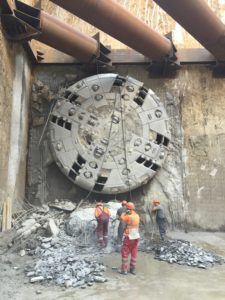
2013年5月24日,USK MOST承建商的罗宾斯盾构机完成了作业。莫斯科的政府官员和承包商一起庆祝了这台直径6.2米(20.3英尺)、破纪录并提前完成作业的盾构机贯通隧道。设备在2013年4月底的实现了日进尺37.8米(124英尺)的速度,刷新了俄罗斯在6 – 7米(20到23英尺)直径范围内的盾构机的掘进纪录
2015年,第5台罗宾斯盾构机加入了这个项目。这台机器为承包商Evrascon作业,并采用了首次现场安装调试方案(OFTA)进行组装的。它在坚硬的粘土、沙子、砾石、卵石、坚硬的石灰石和水里开挖长4公里的隧道,并在2016年5月贯通
2015年10月24日,莫斯科地铁创下了一个里程碑。直径6.65米(21.8英尺)的罗宾斯盾构机完成了它的第二段隧道,长2.5公里(1.6英里)。2014年1月,盾构机已经贯通了第一段长2.1公里(1.3英里)的隧道。承包商SMU Engeocom计划在第三段隧道中再次使用这台机器,这将不是第一次在莫斯科地铁上使用盾构机。Engeocom拥有另一台直径6.65米(21.8英尺)的罗宾斯盾构机,在2015年9月底完成了它的第二道隧道,并将继续作业开挖额外隧道。
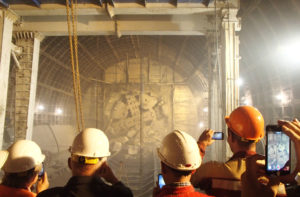
2017年2月01日,为施工商USK MOST作业曾破纪录的罗宾斯盾构再次投入使用,开始掘进它在莫斯科地铁项目中的第4段隧道。这条新隧道将长约2公里,将为“Kozhukhovskaya”地铁线连接接“Kosino”和“Ulitsa Dmitrievskogo”站。这个地区的地质情况非常困难,预计还会有流沙。此外,这台机器将在现有铁路轨道下行驶。该机器目前由Mosinzhproekt的子公司–MIP-Story #1公司拥有,它是莫斯科地铁项目的主要承包商和设计院。
坚实的罗宾斯盾构机能够为莫斯科地铁开挖更为复杂的混合地质隧道。
更多项进程将会陆续跟新。

 Close
Close  Menu
Menu 
